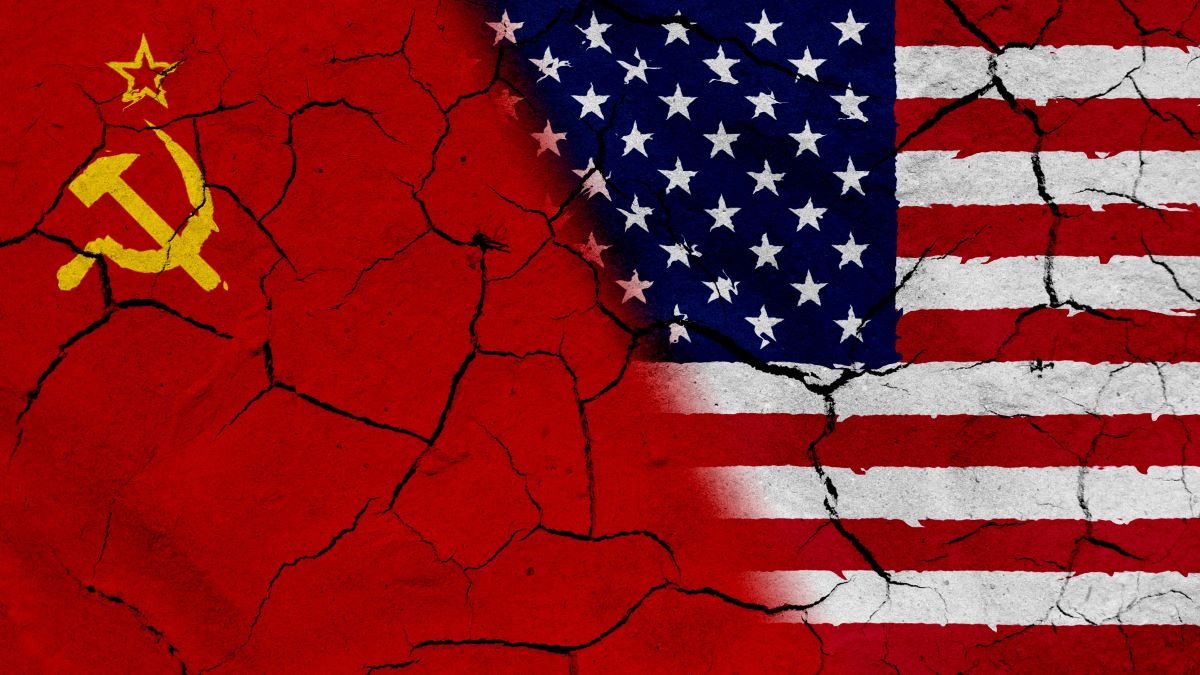On the surface, World War II settled the unrest and evil plaguing the world. Hitler and his Nazis were defeated, along with his Axis allies Japan and Italy. The world could finally rest easy… or could it?
Following Germany’s surrender on May 8, 1945, and subsequently Japan in September, the spoils were divided between the Allied victors. The period following that war, from around 1947 to 1991, was known as the Cold War. What did that term mean exactly?
‘You and the Atom Bomb’
The term Cold War was coined by famous writer George Orwell, the author of the classic dystopian surveillance novel 1984. In an article called ‘You and the Atom Bomb‘ from 1945, Orwell predicted there would be a global impasse where “two or three monstrous super-states, each possessed of a weapon by which millions of people can be wiped out in a few seconds.”
That state of being, he posited, would “probably prevail in a state which was at once unconquerable and in a permanent state of ‘cold war’ with its neighbours.” He also called it an indefinite “peace that is no peace.”
It became even more prevalent when presidential adviser Bernard Baruch gave a speech in 1947 at the Columbia State House in South Carolina. In a scathing attack on America’s labor problems during the peak of the industrial movement, he told the country to “not be deceived – we are today in the midst of a cold war.” America’s enemies, he said, are “to be found abroad and at home.” He also preached self reliance: “peace of the world is the hope and the goal of our political system; it is the despair and defeat of those who stand against us.”
The cultural force of these two events was enough to push the idea to newspapers around the globe, with the conflict described as a war “without fighting or bloodshed, but a battle nonetheless.”
The Cold War begins in earnest
Once Nazi Germany was defeated, the alliance between the United States and the U.S.S.R. shattered. The inevitable underlying tensions between superpowers after they carved up the Nazi territory quickly developed into full-blown distrust, and by 1948 the Soviet Union was installing governments in countries they liberated in so-called American territory. This put America and Europe on edge, fearing that Communism could once again spread worldwide.
To combat this, the United States came up with the Marshall Plan, a program to help boost the economy of those countries Russia was influencing. The fear was that rampant poverty and unemployment could sow the conditions that led to the rise of Communism in the first place. In response in Eastern Europe, Russia installed its own openly communist governments.
From 1948 through 1953, things got especially testy. The Soviet Union tried to blockade West Berlin and the U.S. and Europe started the North Atlantic Treaty Organization (NATO), created specifically to push back against Soviet encroachment. Then came the atomic bombs, which Russia would soon develop themselves. This was colloquially known as the arms race, which would heat up again in the ’60s and again in the ’80s. However, this was around 1949, around the same time Chinese communists took over their own country.
Next came the Korean War, when North Korea invaded the South. That war ended in 1953 and things simmered down a bit, especially since dictator Joseph Stalin passed away that same year. Around this time, Soviet-led countries formed the Warsaw Pact, with countries like Albania, Bulgaria, Czechoslovakia, East Germany, Hungary, Poland, and Romania signing on. In response, West Germany was brought into NATO in 1955.
Things heated up again around 1958, when intercontinental ballistic missiles came into play. Those are missiles with the ability to travel 5,500 miles or more, and by 1962 the Soviets started surreptitiously placing missiles in Cuba, leading to one of the benchmarks of the Cold War: the 1962 Cuban Missile Crisis.
The Cuban Missile Crisis
In Oct. of 1962, an American spy plane discovered a shocking fact – there were nuclear missile sites built by the Russians on the island of Cuba. President John F. Kennedy kept his cards close to his chest, not wanting to let Russia know he was aware of the issue. After meeting with his advisers, he decided to blockade the island to stop Russia from installing any more missiles.
Kennedy addressed America on Oct. 22, and for thirteen very tense days the world was on the brink of the nuclear war. Despite the apocalyptic insinuations, Soviet leader Nikita Khrushchev seemed to understand that a global nuclear war was bad for everyone. Eventually, the Soviets dismantled the sites with an agreement that Cuba wouldn’t be invaded. Secretly, the United States got rid of sites in Turkey. Despite the armistice, the arms race continued.
The Fall of the Berlin Wall and the End of the Cold War
A lot happened between the end of the missile crisis and the fall of the Berlin Wall, with the Vietnam War also in the mix. Fast forward to November 1989. The communist German Democratic Republic decided to open the borders between East and West Berlin, and many Americans saw this moment as the true end of the Cold War.
Public opinion shifted dramatically after the wall came down, and most Americans felt that it meant a more peaceful world. By 1991, then-Soviet leader Mikhail Gorbachev had decided to “loosen the yoke” of control over Eastern European countries. By around Christmas, the Kremlin lowered the hammer and sickle flag and replaced it with the current tricolor one.
The transition from Communist behemoth to a large number of separate nations happened rapidly and peacefully, and the Cold War era, for all intents and purposes, was over for good.
